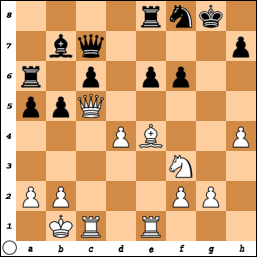
P Is For Pin II
Greetings,
This week's position comes from my Septcenchessial!
Paul Anderson vs Eugin Pahk (Online Game Viewer: http://cschess.webs.com/ )
White to move.

The July Quick Swiss, which is held every 3rd Tuesday, has been rated:
http://www.uschess.org/msa/XtblMain.php?201307167112
Make your plans to attend the Winter Springs Open! Supporting members of the CSCC get a discount.
The events shown below are ones that have been or will be advertised in Chess Life or Chess Life for Kids:
| Date | Event | Location | TLA in | Affiliate |
| 2013-12-07 | 2013 Manitou Springs: Winter Springs Open | Manitou Springs CO | 2013-09 CL | A5012031 |
Read The Newsletter!
http://cschess.webs.com/apps/blog/entries/show/30694320-p-is-for-pin-ii
1. Game Of The Week: P Is For Pin II
2. This Week In Chess: Quick Swiss Results
3. Tuesday Night Chess Tour Cumulative and 3rd Quarter standings
4. Video: http://www.youtube.com/watch?v=cBkRXEz1pcg
2013 Calendar Of Events for the Colorado Springs Chess Club:
http://cschess.webs.com/apps/calendar/
For additional events, see the following websites:
Denver Chess Club: DCC (http://www.denverchess.com)
Colorado State Chess Association: CSCA (http://colorado-chess.com/)
Wyoming Chess Association: WCA (http://www.wyomingchess.com/)
ps - Newsletter preview with pgn:
Game Of The Week
Last year, I came up with a method to organize chess tactics. I called it the DROP Method (http://cschess.webs.com/apps/blog/categories/show/1378181-drop-method). The DROP method is an acronym for the basic kinds of tactics. It is meant to remind you not to drop your pieces and help you get your opponent to drop theirs.
I said that the DROP Method was a work in progress, and it was. So, I thought I would revisit each of the four kinds of chess tactics to clarify and improve the method:
- The first kind of tactic in the DROP Method is Discovery, which I revisited on April 8th (http://cschess.webs.com/apps/blog/show/25494358-d-is-for-discovery).
- The second kind of tactic in the DROP Method is Removal, which I revisited on June 8th (http://cschess.webs.com/apps/blog/show/27861646-r-is-for-removal-ii).
- The third kind of tactic in the DROP Method is Overload, which I revisited on June 23rd (http://cschess.webs.com/apps/blog/show/28998331-o-is-for-overload-ii).
- The fourth kind of tactic in the DROP Method is Pin.
Pin is a chess move that immobilizes an opponent's piece.
The Pin is different from the other kinds of tactics in that it does not create multiple threats. Its main function is to prevent a piece from moving. A Pin on a target allows that target to be attacked by a lower value piece. A Pin on a support allows the capture of the piece the support is guarding.
"The defensive power of a pinned piece is only imaginary." (Aaron Nimzovich)
The Pin works by threatening a low value piece that has a higher value piece behind it. The low value piece is stuck (as if with a pin) to the higher value piece due to the loss of material should the low value piece move and allow the capture of the higher value piece. If the higher value piece is the King, the low value piece is absolutely immobilized as the rules of Chess do not allow moves where the King could be captured. Otherwise the Pin is relative, as the opponent can actually move the low value piece if he is willing to accept the loss of material. The other types of Pins are rare:
- Absolute (Pins a target to the King)
- Relative (Pins a low value target to a higher value piece)
- Cross (Multiple Pins on one piece)
- Cross-check (blocks check and counter-checks)
Here is an example I found while going through the database of my 708 USCF-rated chess games. I noticed that I had recently played my 700th tournament chess game. Since these round numbers often have special events that coincide with them, I decided to look over my Septcenchessial to see if it deserved fireworks and a parade.
It did not.
I tried to play a "bishing pole" attack I had learned from LM Brian Wall's emails (http://games.groups.yahoo.com/group/BrianWallChess/), but Eugin was not interested in my bait. Of course, the bishop as bait seems less effective than the knight. It is hard to just ignore the knight like Petrosian found out against Tal in this line they analyzed for GM Pal Benko when he played GM Bobby Fischer.
After my "bishing pole" attack failed, I reorganized my pieces until I found myself in this position. There are a number of good moves here but see if you can find the tactical shot. It is white to move...
P Is For Pin II
http://www.chessvideos.tv/chess-game-replayer.php?id=82548
[Event "June Mating Game"]
[Site "Colorado Springs"]
[Date "2013.06.18"]
[Round "3.4"]
[White "Anderson, Paul"]
[Black "Pahk, Eugin"]
[Result "1-0"]
[ECO "D61"]
[WhiteElo "2056"]
[BlackElo "1079"]
[PlyCount "71"]
[EventDate "2013.06.11"]
[TimeControl "1800"]
1. d4 d5 2. c4 c6 3. Nc3 Nf6 4. Nf3 e6 5. Bg5 Be7
6. e3 O-O 7. Qc2 Nbd7 8. O-O-O a5 9. Kb1 dxc4 10. Bxc4 b5 11. Bd3 Bb7 12. h4
Re8 13. e4 Nf8 14. e5 Nd5 15. Nxd5 Qxd5 16. Be4 Qd7 17. Bxe7 Qxe7 18. Qc5 Qc7
19. Rc1 Ra6 20. Rhe1 f5 21. exf6 gxf6 22. Qxb5 Rb6 23. Qc5 Nd7 24. Qh5 Nf8 25.
Qxe8 Qd6 26. Rc3 Ba6 27. Rxc6 Rxc6 28. Qxc6 Bd3+ 29. Ka1 Qb4 30. Bxd3 a4 31. a3
Qb3 32. Bc4 Qb8 33. Bxe6+ Kh8 34. Bf5 Qb3 35. Qxf6+ Kg8 36. Qd8 1-0
Paul Anderson
Chess Coach (http://cschess.webs.com/coaching.htm)
Cell: 719-310-9635
Facebook: paul.anderson.904750
Twitter: @cschessnews
Youtube: cschessnews
